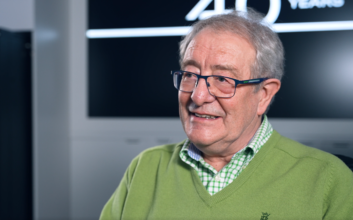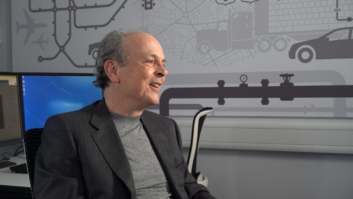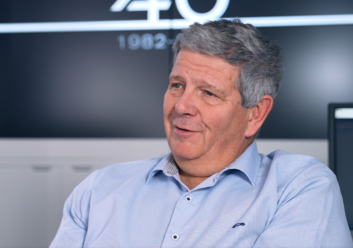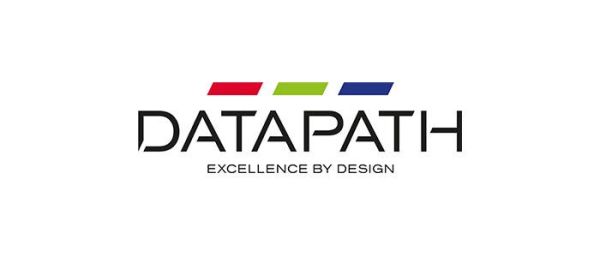With Datapath celebrating its 40th anniversary this year, the company’s original three founders joined staff for an afternoon of celebrations—complete with Birthday cake, bottles of fizz, nostalgic videos, and stories aplenty—at the Derby, UK headquarters.
Tony Jones, Steve De’Ath, and Brett Butcher, who started Datapath from humble beginnings in 1982, shared their experiences of an incredible journey.
“The three of us originally worked in Rolls Royce Electronics Lab, where there were about 50 engineers,” explained Jones. “It was a talented team of electronic engineers, physicists, and mathematicians.

“Our remit was to develop any equipment that Rolls Royce needed for their own internal use. They needed to make all sorts of weird and wonderous measurements on the engines as they were developing them, and if they couldn’t go out and buy the equipment commercially then we would develop it. But nothing ever went into production, as we would make one-off units for the purpose of a test or measurement, so we were basically acting as consultants to the rest of the company.
“And we just thought ‘you know what? we could do this for ourselves’. We could become consultants and design products for other people. And that was the first idea. We started off doing that, but we also realized that all we would be doing is selling our time by the hour. It wasn’t scalable.
“What we really needed was a product of our own, which we could develop and manufacture and sell over and over again. The idea developed and, over the first few months, Steve [De'Ath] sat in a corner developing the Frontier terminal. Brett [Butcher] and I did a variety of bespoke consultancy jobs including a beer flow monitor and the cash till. We would bring in the cashflow to fund Steve developing the terminal, and gradually dropped the consultancy and went purely into the beginning in what Datapath has become today.”
[Datapath Announces Additional Control Room Capabilities with Aetria Release]
TERMINAL SUCCESS
The Terminal was the key product in Datapath’s early success. “We got hold of a very early sample of a graphics chip being made by NEC,” said Jones. “It was this graphics chip we used in the Terminal, and we found sales were very successful almost straight away.
“We were competing with products at the time that were quite expensive, and we could make ours better quality at a competitive price. We started to win the CAD system companies and system integrators that built those CAD systems for drawing offices. There were other applications for the Terminals, but they were the bulk of sales.”
Back in the early 80s, when the team was selling the Terminals, a computer system consisted of a central computer, “which could be a mainframe or a minicomputer, with terminals hanging off that”, multiusers, each with a terminal connected to the central computer. “That was the business model until the IBM PC started to become established, and over quite a short period of time, everyone started to get PCs and the minicomputer market just died,” said Jones.
[The Nine 2022: Meet 9 Pro AV Superstars]
“Had we not been adaptable and moved with the times, we would have died of death as well. I can think of two other UK companies at the time who were making graphics terminals that disappeared because they didn’t change.”
Jones and the others moved into the development of plug-in cards, specifically for the IBM PC. “It was an inflection point, a point in time where our direction had to change to survive,” he said. “That happened again when MS windows became the standard, and PC users no longer needed a specialized graphics technology because the Windows systems came with Windows accelerator cards and could perform those functions. So again, that was the end of that particular phase of graphics card that we were making.
“There have been other points when technology changed, and we had to change with it. Another one was when we were making multi-screen desktop solutions for the financial dealer markets, banks and stocks and shares. In the late 90s, the way trading was done changed in that market and our products were no longer suitable which led us to start making video wall solutions, an extension of the multiscreen desktop.
“I feel we’re at another point now, where things are moving from baseband video to video-over-IP, where we have developed products for that market (Aetria and Aligo) that will take us onto another course now.”
[Datapath Appointments for Key European Territories]
PROUD MOMENT
Winning the Queen’s Award was an exceptionally proud moment for Jones. The team won it twice: in 2005 for Export Achievements, and for Technology Innovation for the methodology they used for the VSN controllers.
“Each time, we got a nice certificate signed by the Queen, and by the Prime Minister at the time (one from Tony Blair and the other from David Cameron),” explained Jones. “And we got to meet the Queen.
“I don’t think I could have ever conceived of the way the business has grown. It’s important to me that we have built the company into a position where it can continue for many years after we’ve gone. You won’t even notice when I’m gone now, and the company will continue to get better and better, I’m sure.”
CONSULTANCY START-UP

Datapath started off as a consultancy, explained De’Ath, working for people who wanted things custom designed. “The first thing we designed was a beer flow monitor, which basically measured how many half pints went down a pipe to and from a beer pump,” he said. “That was done for a company that supplied equipment to breweries, and it was used to measuring how much beer was dispensed in managed pubs to prevent fraud. We did that before Datapath really started.
[SCN Top 50 Systems Integrators 2021]
“Another project was for a cash till, a multiuser cash till such as those is used in pubs everywhere now, where you press a name for a different user. Then we designed a graphics euro card, using an NEC chip which was one of the first graphics processors ever launched by anyone.
“We then wrote some software to do a Tektronix emulation, as in those days Tektronix was the market leader in graphics terminals. Any big CAD based companies had lots of these very expensive terminals. They were vector based and could only draw lines, a bit like an etch a sketch. So, we developed the Frontier terminal, which emulated a Tektronix terminal, but which was raster based and was able to draw the same picture in color.” Moving and monitoring data had become the team’s forte.
“The Frontier terminal was very competitive,” De’Ath continued. “We sold a lot of those, to mainframe/ minicomputer users. That was a good market for a while, until things changed with the advent of the PC. Companies who used CAD started thinking they could use PCs which were cheaper, so we developed the Q-PC card, a plug-in graphics accelerator card.
“Every CAD package a needed a specific driver to interface with this non-standard hardware. Running under the DOS Operating System, but with a Q-PC card and an appropriate driver, it would make the graphics go ten times faster.
When Windows came along, all graphics cards became the same, and they just needed to support Windows and you got every CAD package. Once Windows took off and became more serious, it completely wiped that market out for us, in such a rapid space of time.”
EARLY DAYS

The early days were “a bit chaotic really,” according to Butcher. “There was literally just three of us, and a couple of others that would come in and help. We were working on consultancy projects, but at the same time developing our own products. We thought consultancy was a route to funding development of our own products. Consultancy is money for time, but we wanted products that we could stamp out like a cookie cutter and bang them out. Theoretically that was the idea. We did the beer flow monitor first, testing it out in Steve’s bathroom.
“When developing the cash till I spent a lot of time at the clients’ location each day working on a very expensive Intel plug-in emulator system to write software in assembler language. The software as a multitasking and multiuser real time operating system.
[InfoComm 2022 Registration Is Open]
“We wrote another version of this operating system called RCOS—a real-time control operating system, which we sold to another local company, who went on to use that in their own control systems.
“Every day was different. We had some interesting projects to work on and we had some interesting challenges. Running out of money was a very real possibility a couple of times. We had clients going bust when we had developed products for them, but when we found our first big steady client (I remember Tony meeting them in a motorway service station), that set us off really.”
In the early days, the team had big orders and all the packaging and product boxes would “just stack up in the corridors and offices”, waiting for the customer to collect them, “but in the meantime annoying everyone” having to walk around them. “It was nuts. Busy. Great fun,” explained Butcher.
“I think we were really lucky in a lot of ways,” he added. “We spent a lot of time together at Rolls Royce at the bench. We used to bounce off each other, with ideas. Tony was always very entrepreneurial, he was known as the watch man, he would go to buy watches in London, and he had a regular trade selling watches at the bench, every day he would have a queue selling these new-fangled digital watches.
“Steve was this incredible electronics designer. I was more interested in the software and probably quite good at selling, so took bit more of the job as the business front man. But it was all of us really, we did complement each other very well. And It was great fun.”
